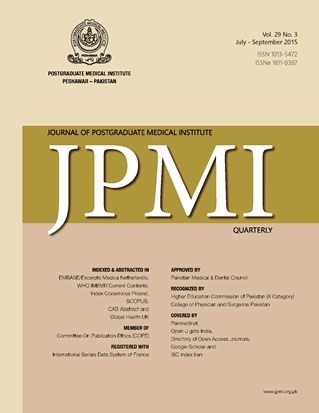COMPARISON OF BIPP GAUZE PACKING VERSUS MAXILLARY ANTRUM PACKING WITH FOLEY'S CATHETER AFTER CALDWELL - LUC SURGERY IN TERMS OF RE- BLEEDING AND DISCOMFORT
Main Article Content
Abstract
Objective: To compare efficacy and discomfort caused by maxillary antrum
packing with Foley's catheter versus BIPP gauze packing after Caldwell-Luc
surgery.
Methodology: This Quasi experimental study was carried out at two centres
CMH Kharian and PAF Hospital Faisal, Karachi from June 2012 to June 2014. A
total of 46 patients who underwent Caldwell-Luc surgery were included in the
study. The cases were divided in two groups of 23 each. In Group A patients,
maxillary antrum was packed with Foley's catheter after Caldwell-Luc surgery
and in Group B patients, packing was done with BIPP gauze. Results in terms
of efficacy and discomfort were observed. Efficacy was assessed by control
of bleeding and subjective discomfort was assessed based on VAS (Visual
Analogue Scale).
Results: In Group A average age of patients was 36.30(SD+13.52) and in
Group B average age of patients was 39.65 (SD+13.84). There were 56.52%
males in Group A and in Group B there were 60.86% males. Whilst the pack
was in situ, average pain score in Group A (Foley's catheter pack group) was
4.09 (SD+0.73) and in Group B, average pain score was 4.17(SD+0.83). On re-moval of pack, pain caused by BIPP gauze was significantly higher i.e average
pain score of Group B was 7.30 (SD+1.10), however that of Group A was 5.13
(SD+1.32) (p<0.001). There was no case of bleeding after pack removal which
showed that both types of packing are equally effective.
Conclusion: Maxillary antrum/antral packing with Foley's catheter is equally
effective as compared to BIPP gauze packing and causes significantly less pain
on removal as compared to BIPP gauze pack after Caldwell-Luc surgery.
packing with Foley's catheter versus BIPP gauze packing after Caldwell-Luc
surgery.
Methodology: This Quasi experimental study was carried out at two centres
CMH Kharian and PAF Hospital Faisal, Karachi from June 2012 to June 2014. A
total of 46 patients who underwent Caldwell-Luc surgery were included in the
study. The cases were divided in two groups of 23 each. In Group A patients,
maxillary antrum was packed with Foley's catheter after Caldwell-Luc surgery
and in Group B patients, packing was done with BIPP gauze. Results in terms
of efficacy and discomfort were observed. Efficacy was assessed by control
of bleeding and subjective discomfort was assessed based on VAS (Visual
Analogue Scale).
Results: In Group A average age of patients was 36.30(SD+13.52) and in
Group B average age of patients was 39.65 (SD+13.84). There were 56.52%
males in Group A and in Group B there were 60.86% males. Whilst the pack
was in situ, average pain score in Group A (Foley's catheter pack group) was
4.09 (SD+0.73) and in Group B, average pain score was 4.17(SD+0.83). On re-moval of pack, pain caused by BIPP gauze was significantly higher i.e average
pain score of Group B was 7.30 (SD+1.10), however that of Group A was 5.13
(SD+1.32) (p<0.001). There was no case of bleeding after pack removal which
showed that both types of packing are equally effective.
Conclusion: Maxillary antrum/antral packing with Foley's catheter is equally
effective as compared to BIPP gauze packing and causes significantly less pain
on removal as compared to BIPP gauze pack after Caldwell-Luc surgery.
Article Details
How to Cite
1.
Khan MA, Jawaid A, Faiz S bin. COMPARISON OF BIPP GAUZE PACKING VERSUS MAXILLARY ANTRUM PACKING WITH FOLEY’S CATHETER AFTER CALDWELL - LUC SURGERY IN TERMS OF RE- BLEEDING AND DISCOMFORT. J Postgrad Med Inst [Internet]. 2015 Dec. 12 [cited 2025 Dec. 5];29(3). Available from: https://jpmi.org.pk/index.php/jpmi/article/view/1652
Issue
Section
Original Article
Work published in JPMI is licensed under a
Creative Commons Attribution-NonCommercial 2.0 Generic License.
Authors are permitted and encouraged to post their work online (e.g., in institutional repositories or on their website) prior to and during the submission process, as it can lead to productive exchanges, as well as earlier and greater citation of published work.


